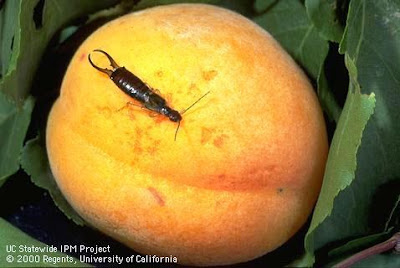
The munching insects appear out in force this spring

|
|
Earwigs won't kill mature plants, but they'll destroy
seedlings and damage soft fruit and berries. (Photo
courtesy UC Integrated Pest Management)
|
One insect apparently liked our roller-coaster spring: Earwigs.
“We’ve gotten a lot of questions about earwigs,” says Kevin Marini, community education specialist for the UCCE Master Gardeners of Placer County. “There’s always a pest every year that rears its head and becomes ‘The Pest of the Year.’ We’re still waiting, but by all appearances, maybe it’s earwigs.”
Earwigs eat holes – especially inside rose flowers or through heads of lettuce. They usually won’t kill a mature plant, but they can be death to seedlings.
“Earwigs are very, very challenging for emerging plants,” Marini says. “Direct seedlings or little transplants; they just get munched.”
With their pinchers, earwigs are very distinctive among common garden insects. Their little forceps-like hooks are used for defense (although they rarely bite people).
About an inch long when mature, earwigs can do serious damage to soft fruit and berries (such as apricots, strawberries, raspberries or blackberries) and corn.
But they also are a major predator of aphids; that makes earwigs a garden good guy, too.
Anecdotally, the earwigs may be tied to late spring showers.
“We got sporadic rain; not much, but just enough,” Marini observes. “Late rain can cause outbreaks of earwigs.”
The moisture cups inside roses, lettuce heads and other places that earwigs like to hide – and eat.
On the other hand, early spikes in heat may have held down aphid invasions, Marini observes. “We’ve had hardly any calls on aphids – but that can change in a week.”
Maybe all those earwigs were hungry?
For more about earwigs: http://ipm.ucanr.edu/PMG/PESTNOTES/pn74102.html
Comments
0 comments have been posted.Sacramento Digs Gardening to your inbox.
Food in My Back Yard Series
May 6: Maintain soil moisture with mulch for garden success
April 29: What's (already) wrong with my tomato plants?
April 22: Should you stock up on fertilizer? (Yes!)
April 15: Grow culinary herbs in containers
April 8: When to plant summer vegetables
April 1: Don't be fooled by these garden myths
March 25: Fertilizer tips: How to 'feed' your vegetables for healthy growth
March 18: Time to give vegetable seedlings some more space
March 11: Ways to win the fight against weeds
March 4: Potatoes from the garden
Feb. 25: Plant a fruit tree now -- for later
Feb. 18: How to squeeze more food into less space
Feb. 11: When to plant? Consider staggering your transplants
Feb. 4: Starting in seed starting
Sites We Like
Garden Checklist for week of May 4
Enjoy this spring weather – and get gardening!
* Plant, plant, plant! It’s prime planting season in the Sacramento area. Time to set out those tomato transplants along with peppers and eggplants. Pinch off any flowers on new transplants to make them concentrate on establishing roots instead of setting premature fruit.
* Direct-seed melons, cucumbers, summer squash, corn, radishes, pumpkins and annual herbs such as basil.
* Harvest cabbage, lettuce, peas and green onions.
* In the flower garden, direct-seed sunflowers, cosmos, salvia, zinnias, marigolds, celosia and asters. (You also can transplant seedlings for many of the same flowers.)
* Plant dahlia tubers. Other perennials to set out include verbena, coreopsis, coneflower and astilbe.
* Transplant petunias, marigolds and perennial flowers such as astilbe, columbine, coneflowers, coreopsis, dahlias, rudbeckia and verbena.
* Keep an eye out for slugs, snails, earwigs and aphids that want to dine on tender new growth.
* Feed summer bloomers with a balanced fertilizer.
* For continued bloom, cut off spent flowers on roses as well as other flowering plants.
* Add mulch to the garden to maintain moisture. Mulch also cuts down on weeds. But don’t let it mound around the stems or trunks of trees or shrubs. Leave about a 6-inch to 1-foot circle to avoid crown rot or other problems.